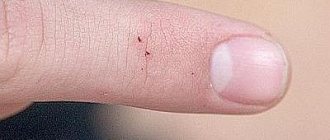Cats are very clean animals, constantly caring for their fur. A healthy pet always has a shiny coat, clean and smooth skin.
The appearance of bald patches, crusts or scabs on the body of a furry pet may be a signal that the cat is developing demodicosis, a disease caused by the scabies mite Demodex cati . The parasite is present in the epidermis of any cat and is considered an opportunistic microorganism.
Under the influence of some unfavorable factors that negatively affect the health of the animal, the tick begins to actively reproduce, leading to pathological changes in the skin.
What is demodicosis
Demodicosis is an intradermal parasitic disease that is caused by a subcutaneous mite - Demodex, it belongs to scabies mites, so synonyms for the disease are “red scabies”, “demodex” or “hypodermic mite”.
Different species of animals and humans suffer from demodicosis, and each has its own tick: that is, a cat suffering from demodicosis is not dangerous to humans.
There are two types of mites found in cats: Demodex cati and Demodex gatoi.
The tick itself is microscopic in size (200-300 micrometers), has an elongated body, divided into a head, chest and abdomen; it also has upper and lower jaws, and four pairs of short legs. It is this structure that determines the features of its existence and life cycle.
Normally, small numbers of Demodex cati mites live in the hair follicles and sebaceous glands of each cat. They become the cause of disease only when the animal’s immunity is weakened.
If a cat has another type of tick - Demodex gatoi, which lives on the skin, then infection occurs through close contact between a sick and healthy animal: when sniffing or when cats rub against each other, or when the cat has access to fragments of skin and fur with ticks. Such a fragment can be brought home by the owner, which is called “on his feet.”
A tick, once on the skin, uses its entire arsenal - a proboscis on the head, an elongated body, jaws, limbs - to gnaw through the surface layer of the skin and, going deeper, penetrates the hair follicle or sebaceous gland. Here, for its life activity, there is everything necessary: the appropriate temperature, secretions (specialized substances) of the follicles and glands, blood, lymph, fragments of dead cells. All these conditions necessary for the life cycle of each tick species are different: from the moment of laying eggs to the development of an adult. In general, this takes 25-30 days.
According to statistics, demodicosis is rare in cats, but the consequences for the animal’s body, the danger to other cats and long-term treatment make this disease very serious and requiring treatment only from a veterinarian. It is important to remember: if a cat has a weakened immune system or has other health problems, the disease will not cure itself.
Preventive measures
In order to avoid symptoms and treatment of subcutaneous mites in cats in the future, it is necessary to take care of prevention in advance. First of all, regularly treat the animal with antiparasitic drugs (for fleas and ticks), check for worms and monitor the balance of the pet’s diet. A cat's diet should be rich in all necessary vitamins and microelements.
You should not allow your pet near animals whose health status is in doubt. It’s better to play it safe than to later discover demodicosis in your cat. Also try to maintain your pet’s immunity; your veterinarian will prescribe the necessary medications.
Although today there are many medicines for the treatment of subcutaneous mites, it is better not to deal with this disease. And not even because a lot of time passes from diagnosis to recovery. First of all, the cat suffers, for which demodicosis brings a lot of discomfort. And if you take preventative measures, your pet will always be healthy.
You can now see the current price of anti-tick medications and buy them right here:
Causes of demodicosis in cats
For demodicosis, the gender, breed or age of the animal is not important, but some veterinarians, from their experience, speak of a predisposition in Siamese and Burmese breeds.
The following are susceptible to demodicosis:
- cats with weakened immune systems: recent infectious diseases, treatment with antibiotics, hormones; infected with fleas, helminths; having diseases of the endocrine system;
- adult cats over 5 years old and elderly animals;
- cats under 1-2 years old
- kittens taken early from their mother, i.e. those who have not received enough immune bodies from breast milk;
- possible intrauterine infection from mother to fetus;
- cats with a genetic predisposition to demodicosis;
- cats with poor skin condition: damage to the integrity of the skin, inflammatory diseases (including as a result of other parasitic, fungal and bacterial infections);
- cats with genetic diseases associated with weakened immunity.
In addition, the development of demodicosis is promoted by:
- stress, which weakens the immune system;
- Violation of conditions of detention: keeping a sick and healthy animal in close proximity; access to the fur and skin of a sick animal;
- violation of the diet, especially in protein balance.
Caring for a sick animal
The most unpleasant thing about caring for a cat is the fear of getting infected. Rumors that feline demodicosis is dangerous for humans are a myth. These diseases have different pathogens, so when treating a cat you need to show all your love. The animal should feel that it is being cared for and not tortured, because all sorts of unpleasant procedures (injections, treatment of wounds, etc.) can cause pain to the animal.
There have been many cases where cats with scabies were so tortured that they lost the will to live, and this should not be allowed. Your task is not only to remove sores and treat wounds, but also to boost your pet’s immunity. If the cat feels comfortable, then it will have the strength to heal.
It is important not to forget about all the procedures prescribed by the veterinarian. Make yourself a reminder and hang it in a visible place. If you cannot stay at home for several weeks or months and actively treat your cat, then immediately buy all the necessary medications, syringes, cotton swabs, etc., and ask someone to help you. Some veterinary clinics have hospitals for sick animals. It is not very expensive, but in such a “sanatorium” the cat will receive qualified care.
And, of course, in the future it is necessary to prevent outbreaks of parasitic mite activity. Prevention should be done even when the animal is already sick.
Video: on how to properly give an injection at the withers
Symptoms of demodicosis in cats
The habitat of Demodex is thin and delicate skin: primarily the ears, nose, eyes, in the mouth area, on the paws.
Manifestations of demodicosis in cats are classified as:
- localized form - limited areas of skin lesions: five or less areas;
- generalized form - the affected areas merge, forming vast fields; in extreme cases, almost the entire surface of the body can be affected.
If the cause of the disease is a mite of the species Demodex gatoi, which lives on the surface of the skin, the cat may experience severe itching. In contrast, the Demodex cati mite lives in the sebaceous glands or hair follicles and does not initially cause much concern to the animal.
Inflammation begins to develop at the site of tick penetration, and therefore the skin here is swollen and begins to turn red (skin hyperemia develops). At the site of Demodex penetration, small tubercles or pustules (3-5 mm in diameter) are formed, from which, when pressed, various liquids can be released: from blood to pus.
If untreated, the bumps can unite and become crusted, and the inflammation can cover large areas of the body, sometimes several parts of the body, and in extremely severe cases, the entire body. Since the skin is affected, its protective function is greatly reduced, and a secondary infection may occur, which significantly aggravates both the general condition of the cat and the duration of treatment.
Do not forget about itching, as a result of which the cat scratches, injures the skin and can itself spread the mite throughout the body, onto the litter and other places.
Common symptoms include:
- general depression of the animal: the cat is inactive, may refuse food;
- increased body temperature; it depends on the degree of spread of the inflammatory process;
- other signs characteristic of an attached infection;
- cachexia (weight loss and emaciation), and in extreme cases, death of animals.
Types of diseases caused by subcutaneous mites
- Actually demodicosis. Develops due to inflammation, which is provoked by waste products of microorganisms. Manifests itself in the form of external damage to the skin and hair.
- Ear scabies is the most common type of demodicosis. Formed when the parasite enters the ear or lymph nodes in this area. It contains many nutrients for mites: skin tissue, earwax, dandruff and other formations. If an animal is affected by a disease, then black dirt appears in the ears, which is the waste products of microorganisms and congealed blood. The main sign of pathology is an unpleasant putrid odor.
Diagnosis of demodicosis
Diagnostics is laboratory only.
Due to the varied form and nature of skin damage, only a veterinarian can determine the true cause. As a rule, the doctor will suggest approximately the following algorithm:
- collecting information about the cat’s life history and illness;
- clinical examination of the animal;
- microscopic examination of skin scrapings.
It is worth considering that if the presence of Demodex is suspected, a skin scraping is taken before the appearance of the ichor, since the mite can only be detected by taking for analysis the cells of the entire thickness of the skin located above the blood vessels. This is due to the fact that the mite penetrates deeply into the skin, and a superficial scraping will be uninformative.
ethnoscience
The use of home remedies in the treatment of demodicosis is allowed only if the veterinarian has not found any restrictions. Moreover, such methods are not suitable for a generalized form of the disease. As folk remedies for eliminating subcutaneous mites, you can:
- Every day, bathe the animal with Doctor shampoo, and then wipe the damaged skin with a decoction of chamomile and sage. To prepare the drug, you need 1 tbsp. l. Pour 0.5 liters of hot water over each plant and cook for 10 minutes. Cool the liquid and warm it up slightly each time before use.
- Bathe your pet with tar soap, and then treat the infected areas with calendula tincture.
- Wipe areas where hair has fallen out twice a day with kerosene. After treatment, do not wash the cat for 2 days.
During the treatment process, it is important to disinfect the pet’s resting place and its belongings. All medications for external use must be warmed to room temperature.
It should be borne in mind that traditional methods can provoke intoxication and other serious consequences.
Treatment of demodicosis in cats
Treatment boils down to eliminating the tick itself. To do this, the specialist will select complex therapy, which may include ointments applied to areas of inflammation, injections of drugs (subcutaneous, intramuscular), bathing in medicated shampoos, or oral administration of drugs (by mouth).
And of course, treatment of associated symptoms, based on the general course of the disease.
In addition, another important area of treatment will be:
- strengthening immunity;
- normalization of skin function and hormonal status, general condition of the body;
- proper nutrition, balanced in proteins and vitamins.
Important to remember:
- Only a veterinarian can establish the correct diagnosis and, depending on the course of the disease, select medications.
- Treatment should not be interrupted even with seemingly positive results; the disease may return with greater force.
- Treatment ends only after two negative scrapings with an interval of one month.
Medicines and injections
When an animal is initially infected, it is quite difficult to decide on the choice of drugs to eliminate parasites. Each type of disease requires its own medications to treat, so it is best to seek help from a veterinarian.
Localized demodicosis
In this case, damage to small areas of the skin is observed. Only a veterinarian selects the drug and can prescribe ointments, shampoos and sprays. Basically, the doctor prescribes the following medications:
- Sulfur or aversectin ointments;
- Unoiled;
- Tsidem;
- Liniment Demos;
- Amit;
- Ivermek-gel.
Do not forget that the products are applied to skin cleansed of hair.
The pet also needs medications to boost its immunity. Usually prescribed:
- Gamavit;
- Immunoparasite;
- Gala Vet;
- Maxidin.
Generalized demodicosis
This type of disease is more difficult to treat because all of the pet’s skin is damaged. Do not despair even if your animal develops ulcers and severe irritation - the disease can be overcome.
To better absorb the medication for external use, the cat should be trimmed and bathed with a special shampoo (Doctor VIC). Then the skin is soaked in sea buckthorn oil, and after it dries, the prescribed medication is treated.
If the disease is severe, injection solutions are prescribed:
- Cydectin – single dose – 0.4 ml;
- Dectomax - the dose is determined by the veterinarian taking into account the pet’s body weight.
The development of complications indicates the addition of a secondary infection. In such a situation, a course of antibiotics is prescribed:
- Betamox;
- Amosina;
- Amoxicillin;
- Kanamycin;
- Baytrila.
It is important for an animal to eat properly. You should include foods rich in vitamins and minerals in your diet.
Prevention
- Avoid contact between a healthy cat and a cat with demodicosis.
- Timely detection of the disease and contact a specialist.
- Timely preventive treatment of cats against ectoparasites that live on the animal’s skin.
- Treating premises, cages, and places of residence of cats infected or suspected of demodicosis with acaricidal preparations, the action of which is directed against ticks.
- It is recommended to destroy bedding, feeders, equipment (rags, brushes, etc.) from a sick animal.











